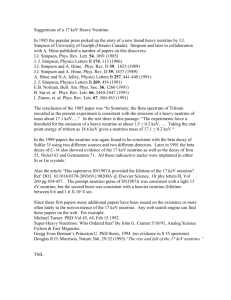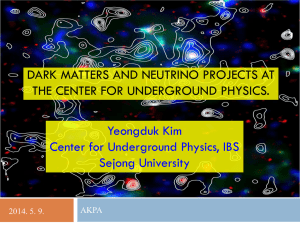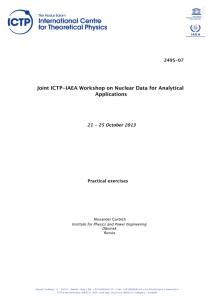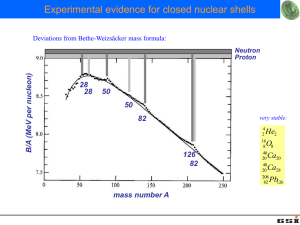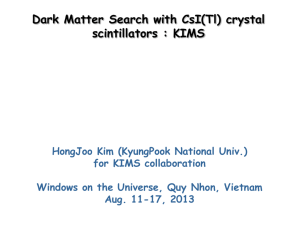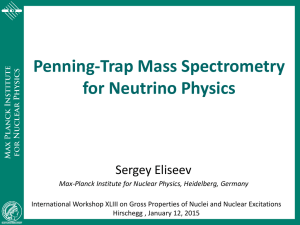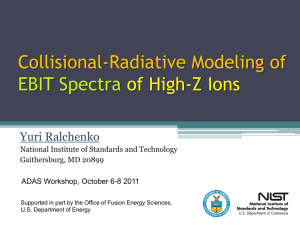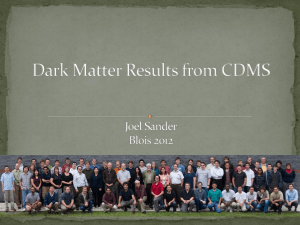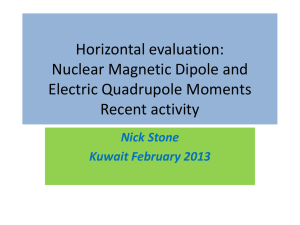Spherical Time Projection Chamber (STPC) for future neutrino and
advertisement
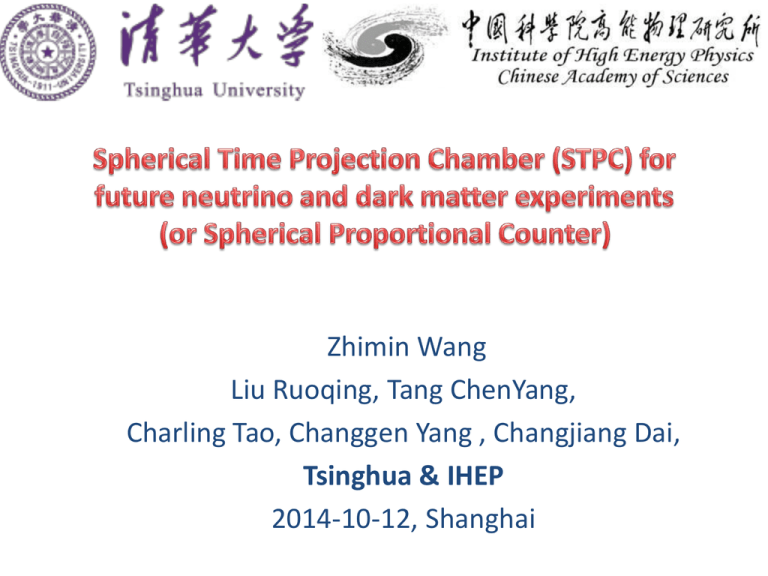
Zhimin Wang Liu Ruoqing, Tang ChenYang, Charling Tao, Changgen Yang , Changjiang Dai, Tsinghua & IHEP 2014-10-12, Shanghai A Simple New Gas Detector Developed by Ioanis Giomataris, Saclay, France • Natural focusing: – large volumes can be instrumented with a small readout surface and few (or even one) readout lines • 4p coverage: better signal • Still some spatial information achievable: – Signal time dispersion • Other practical advantages: – Symmetry: lower noise and threshold with large volume – Low capacity – No field cage • Simplicity: few materials. They can be optimized for low radioactivity. • Low cost 2 A prototype D=1.3 m V=1 m3 Spherical vessel made of Cu (6 mm thick) P up to 5 bar possible (up to 1.5 tested up to now) Vacuum tight: ~10-6 mbar (outgassing: ~10-9 mbar/s) Typical spectra 5 Run with Ar/CH4 + 3g 3He @ 200 mb SPC 130cm Ø @ LSM NB: no start => risetime records place and/or history of energy deposition Rise time (s) If localised energy deposition, rise time depends of radius (diffusion) 210Po 5.3 MeV n capt on 3He 764 keV alpha If track, rise time depends on orientation of track (different drift times) 222Rn 218Po 214Po derivative de/dx Amplitude 6 Run with Ar/CH4 + 3g 3He @ 200 mb SPC 130cm Ø @ LSM Taux 400 capt/j n capt on 3He => p + T Rise time (s) 210Po 5.3 MeV 210Po 5.3 MeV from 210Pb @ Cu surface R = 15 cm n capt on 3He 764 keV 1 2 3 222Rn 218Po 214Po Unwanted Radon daughter deposit on surface Amplitude 2 : fast neutron expected here 7 Basic performance Mixtures tested: – Ar+10% CO2 – Ar+2% Isobutane Pressures from 0.25 up to 1.5 bar tested up to now High gains (>104) achieved with simple spherical electrode No need to go to very high V (better for minimizing absorption) Applications – Dark Matter – Coherent neutrino scattering – Double beta decay – Axion – SN neutrino monitoring ----------------------------------------------------------------------------------– Neutron spectroscopy – Neutron counter for industrial application – Low level neutron counting – Radon low level counting – Atmospheric neutron and Muon monitoring – Gamma ray spectroscopy in harsh environment – … Some physics applications arXiv:1401.7902 Gerbier et al. DM WIMP Reactor neutrino 10 doi:10.1088/1742-6596/203/1/012030 LSM neutron flux From Savvidis ilias An international working group “NEWS” from G. Gerbier Activities at IHEP &Tsinghua Detector performance studies Plan to measure neutrons in Jinping with 1g He3 14 STPC goals • NEWS network: 4m detector. Where? Jinping? SNO? Gerbier in Canada with 10 M$ grant • Training for low radioactivity gaseous detector for large volume TPC Solar neutrino (HELLAZ like) Directional Dark Matter (also an old idea!) 15 Hellaz simulation (1997?) 1995-1998 The HELLAZ solar pp neutrino project Tom Ypsilantis, Jacques Séguinot et al… , with a Micromegas 16 Dark matter detection with hydrogen proportional counters G. Gerbier, J. Rich, M. Spiro, C. Tao Nuclear Physics B - Proceedings Supplements Volume 13, February 1990, Pages 207-208 Comments : for some DM types not Mass but Number of nuclei is important Gaseous detectors are beautiful ! • • 1975-1979 Cylindrical Drift chamber in PhD thesis back for Fermilab DIS muon CHIO in Smithsonian (Washington DC) 1979-1982: UA1 Central Detector 1st W event in UA1 CD Personal interest for > 20 years Technology OK and keeps improving For DM: needs detection from >2 nuclei AND directionality!!! Is our science case compelling enough? CDM vs WDM debate Directional DM Detectors • CYGNUS 2013: 4th Workshop on Directional Detection of Dark Matter Tatsuhiro Naka and Kentaro Miuchi - 2013 J. Phys.: Conf. Ser. 469 011001 Workshop Series Boulby 2007 , MIT 2009, Aussois 2011 • Many projects: DMTPC, NEWAGE, DRIFT, MIMAC • emulsions MIMAC MIMAC bi-chamber prototype 1311.0616 • The MIMAC bi-chamber prototype is composed of two chambers sharing the same cathode being the module of the matrix • active volume (V 5:8 l) • 70%CF4 + 28%CHF3 + 2%C4H10 at a pressure of 50mbar. The primary electron- ion pairs produced by a nuclear recoil in one chamber of the matrix are detected by driving the electrons to the grid of a bulk micromegas and producing the avalanche in a very thin gap (256 mu). • Track reconstruction in MIMAC. The anode is read every 20 ns. The 3D track is reconstructed, from the consecutive number of images Bi-chamber prototype at the Laboratoire Souterrain de Modane The bi-chamber prototype at the Laboratoire Souterrain de Modane in June 2012. The bi-chamber module is identified in red and the bluer volume in blue. The position of peaks of Cd (3.2 keV), Cr (5.4 keV), Fe (6.4 keV), Cu (8.1 keV) and Pb (10.5 and 12.6 keV) tted by a linear calibration in ADC channels as a function of time, highlighting the gain stability during the data taking period. 4. Preliminary analysis of the first months of data taking The first available data set of the bi-chamber prototype was started on July 5th 2012 Background in LSM 23 Electron vs nuclei recoil The length [cm] vs. Energy [ADC channel] of electrons and proton recoils produced by neutrons of 144 keV in pure isobutane (C4H10) at 50 mbar. The maximum of the proton energy corresponds to 144 keV. (Right): The NIS (normalized integrated straggling) for recoil events (in black) and for electrons (in blue). 24 25 1.5 keV He4 recoils 26 3D-Track reconstruction 34 keV Some tracks in MIMAC 8 keV hydrogen nucleus in 350 mbar 4He+5%C4H10, a fluorine nucleus leaving 50 keV in ionization in 55 mbar (70% CF4 + 30% CHF3) and a 5.5 MeV alpha particle in 350 mbar 4He+5%C4H10 28 29 MIMAC 1m3 in preparation WIMP distribution 32
